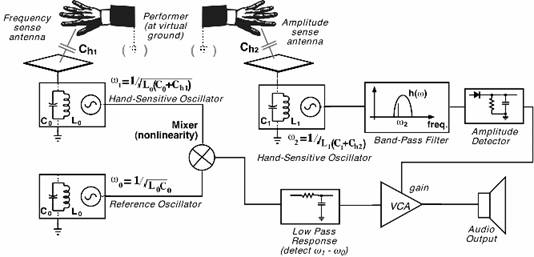Algo del tema aqui:
http://en.wikipedia.org/wiki/Theremin
The theremin was originally the product of Russian government-sponsored research into proximity sensors. The instrument was invented by a young Russian physicist named Lev Sergeivich Termen (known in the West as Léon Theremin) in October 1920[3] after the outbreak of the Russian civil war. After positive reviews at Moscow electronics conferences, Theremin demonstrated the device to Bolshevik leader Vladimir Lenin. Lenin was so impressed with the device that he began taking lessons in playing it,[4] commissioned six hundred of the instruments for distribution throughout the Soviet Union, and sent Theremin on a trip around the world to demonstrate the latest Soviet technology and the invention of electronic music. After a lengthy tour of Europe, during which time he demonstrated his invention to packed houses, Theremin found his way to the United States, where he patented his invention in 1928 (US1661058). Subsequently, Theremin granted commercial production rights to RCA.
Although the RCA Thereminvox (released immediately following the Stock Market Crash of 1929), was not a commercial success, it fascinated audiences in America and abroad. Clara Rockmore, a well-known thereminist, toured to wide acclaim, performing a classical repertoire in concert halls around the United States, often sharing the bill with Paul Robeson.
During the 1930s Lucie Bigelow Rosen was also taken up with the theremin and together with her husband Walter Bigelow Rosen provided both financial and artistic support to the development and popularisation of the instrument.[5][6]
In 1938, Theremin left the United States, though the circumstances related to his departure are in dispute. Many accounts claim he was taken from his New York City apartment by KGB agents,[7] taken back to the Soviet Union and made to work in a sharashka laboratory prison camp at Magadan, Siberia. He reappeared 30 years later. In his 2000 biography of the inventor, Theremin: Ether Music and Espionage, Albert Glinsky suggested the Russian had fled to escape crushing personal debts, and was then caught up in Stalin's political purges. In any case, Theremin did not return to the United States until 1991.[8]
http://asmir.info/theremin_classic.htm
The THEREMIN (aka Theremin-vox) is one of the most distinctive of all electronic instruments. It was invented in 1919 by Russian physicist and musician Lev Sergeyevich Termen, whose name somehow became French-ified to Leon Theremin. It has a unique sound, and a unique design. It's also one of the very few instruments you play without touching. Instead of a keyboard, or strings, it has antennas which sense the movements of your hands in the surrounding space. Those antennas provide a control of pitch and loudness. The pitch antenna is a vertical rod situated in front of the player and slightly to the right. The loudness antenna is placed to the left and fashioned into a horizontal loop so as to be under the horizontal palm of the player's left hand. Movement of the right hand toward the pitch antenna controls pitch, while movement of the left hand toward the volume antenna controls loudness or volume.
Pitch is changed by capacitance of your hand, or whatever goes close to the antenna. The Theremin has two very high frequency oscillators (around 350 kHz). One of them is fixed, and the other is varied by the capacitance of your hand: it's the difference between the two frequencies which decides the pitch. That way, even a 0.05% change in the variable oscillator can be substantial at audio frequency - enough, with good design, to give a range of five octaves.

Thus the audio frequency note is produced by heterodyning the outputs of two ultrasonic oscillators. The fixed oscillator operates in the region of 350 KHz with the variable pitch oscillator being above this frequency, the difference equaling the frequency of the note being played. The position of the right hand is sensed by the change of capacitance it introduces in the pitch antenna, this change controls the frequency of the variable pitch oscillator.
Left hand circuitry derives a control voltage from the loudness antenna, this voltage being used to control the gain of the voltage controlled amplifier and hence the amplitude of the output.
The resulting sine wave output is processed to give more complex waveforms which provide a choice of tone colors in addition to the pure sine wave tone.
The Method...
http://www.electrotheremin.com/claramethod.html
Y a lo que vine, varios videos para pasar las fiestas.
Y a lo que vine, varios videos para pasar las fiestas.
Chequeense el bajo en este:
Una clase, por una de las prodigio modernas del instrumento. Buena explicacion tecnica:
Y algo de relleno adicional aqui:
http://youtu.be/VJ4dfYUlW1whttp://youtu.be/4IG8WYjQdSc
Churn Out...

3 comments:
Aparte de la opera China, no puedo escuchar a Paul Robeson cantar musica de esa que cantan los pentecostales negros. Es in so por ta ble.
Como va la solteria dominante?
Mis proyectos y los deberes de la casa no dan tiempo de pensar mucho en nada. Pero en el neto, ha sido todo mucho mas positivo de lo que imaginaba.
Extra/ne no tener el nene en Navidades, pero lo tuve ayer. Fue un cambio positivo verlo jugar con muchachos de su edad y sobre todo verlo junto a sus otros primos bailando con el Just Dance del X Box...como les gusta la brincadera del juego!
Saludos y felices fiestas...
Post a Comment